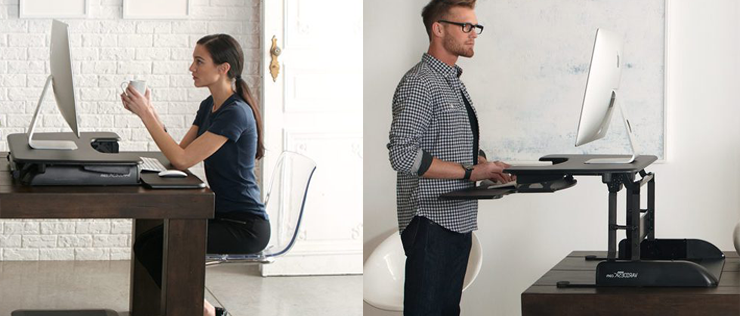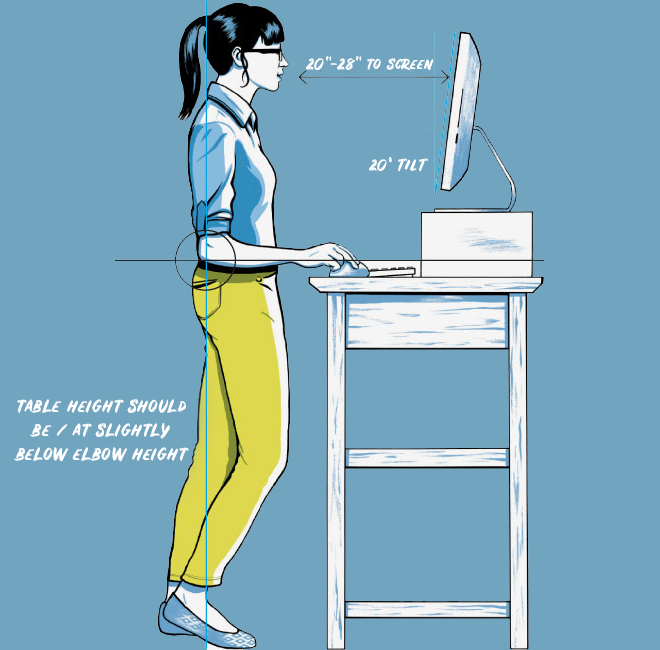The Negatives of Standing Desks
We are constantly hearing about how bad it is for us to sit sedentary at a desk all day long. After all, as a species, we were not designed to sit for long periods of time. The standing desk is making waves – and for good reason – but it is not without its share of drawbacks. With endorsements from well-respected figures such as Mark Zuckerberg, Winston Churchill, Tim Ferriss and Charles Dickens, it’s not surprising people are starting to listen.
There are many things that need to be taken into consideration before making the shift. These are health-related issues, as well as those of finance and practicality.
Physiologists recommend standing up every 20 minutes, even if it is only for a minute or two. By breaking up prolonged sitting by simply standing up, moving and contracting muscles, you will experience a reduced risk of developing diabetes or heart disease, and even premature death. Contracting the muscles in your legs will also lead to an increase in the enzymes that break up fat in your bloodstream, as well as increased blood flow to the brain. Expect improvements in both creativity and productivity, and a doubling of new brain cells created over time. for a deeper look into the benefits see our sit stand desk benefits page.
Are Standing Desks More Healthier Than Sitting Desks?
Whilst it is often said that it is healthier to stand than it is to sit, consistently being in either position will bring its own resultant health problems. Sustained standing can exert increased pressure on joints. Experts recommend ensuring that you are moving, stretching, and swaying whilst standing to mitigate the potential negative effects on your joints.

For any of us who spend many hours a day sitting – which is unfortunately most of us – a sudden transition from sitting to standing can prove quite a shock to the body . Side effects of this sudden transition can include a pooling of blood, which can lead to a swelling of the ankles and feet, giving you very attractive ‘cankles’. This is a common complaint if your legs are not moving enough to maintain adequate blood flow.
It is important that whatever work setup you choose, you don’t become complacent. Whether you are sat or stood, it is imperative to incorporate some form of movement regularly. The movement can take any form you like – the human body does not care – as long as you are moving every 20-30 minutes. As long as you avoid doing any one thing for sustained periods of time without regular and adequate breaks, you are on the right track.
The best workstation setup for most people will be a sit-stand desk. This setup allows you to alternate between sitting and standing as required to ensure that you are not doing too much of one or the other. This gives the opportunity to change between the two as desired and mitigates the health drawbacks of each. You may also want to consider incorporating some of the following suggestions into your day: sitting on an exercise ball or similar to encourage movement while sitting, yoga poses, taking the stairs, holding walking meetings, talking to colleagues in person as opposed to emailing, and moving between workspaces.
Experts recommend a very specific optimal setup for standing desks, outlined by the simple graphic below. It can be difficult to obtain optimal placement with a laptop as you are afforded much less flexibility given that the screen, keyboard and mousepad are in a fixed position. You can get around this issue by getting your hands on a monitor and/or keyboard and mouse. This will give you more control over your workstation setup.

How Much Does Stand Desk Cost?
One of the primary concerns about standing desks is a financial one. The best standing desks can represent a considerable investment which can prove daunting or impossible for some people. Good quality standing desks are usually in the $500-$1,000 bracket, and good sit-stand desks are in the $1,000-$4,000 ballpark. You have to be absolutely sure that you want to use it for the long haul to get your money’s worth. For most, this is too hefty an investment for the home office. For those in the corporate setting, the likelihood of persuading Human Resources to invest in a standing desk for you depends both on the financial clout and the office culture of your company.
There are many working situations that you could find yourself in that would make having a regular standing desk setup a challenge. These include if you are using co-working spaces, moving around between workspaces (perhaps you travel a lot or just like to check out different coffee shops to keep things fresh), maybe you are sharing a workspace or your employer has a hotdesk system in place. For all of these reasons and many more, you may be more likely to find yourself at a standard seated desk.
Achieving the optimal balance between sitting, standing and movement is not easy, especially when you are so used to working in a very different way. In order to make real and sustainable differences, a change in mindset will be necessary. Those who are committed and active in making the change will always reap the best results, as opposed to those who become complacent.
Final Thoughts
The reality of the matter is this: like almost anything in life, standing to work is best done in moderation. The optimal approach involves a combination of standing, sitting and regular movement to combat the negative effects of prolonged sedentary activity. Making the change will take a conscious effort, but will undoubtedly prove itself worth it in the short term and even more so in the long term.



